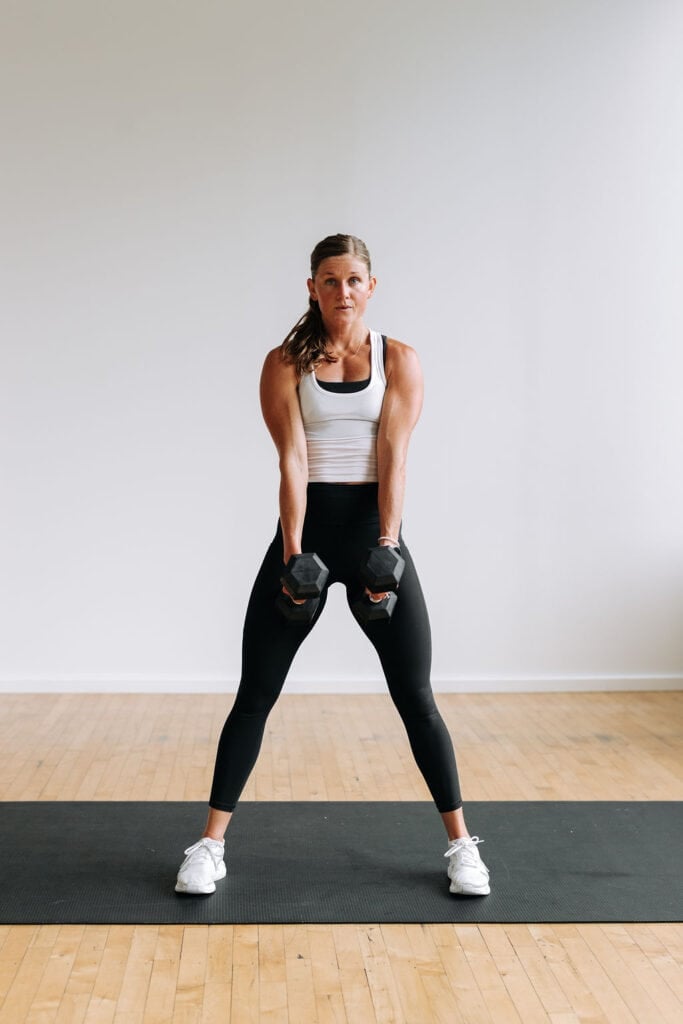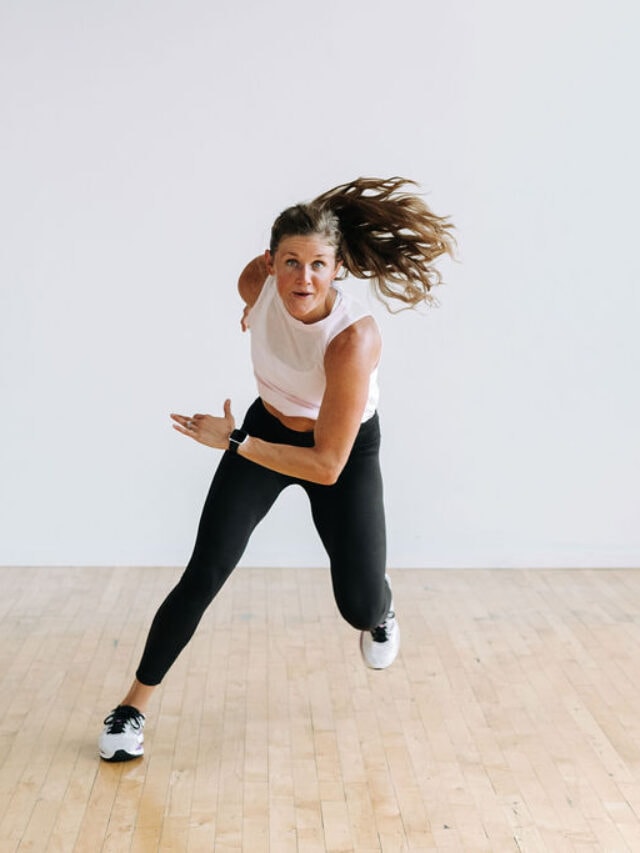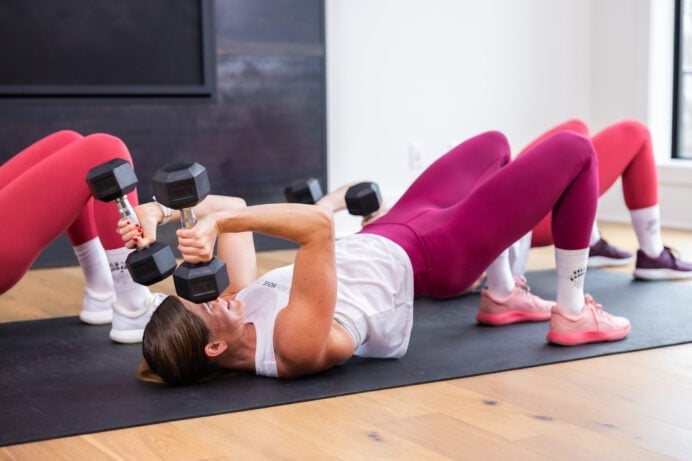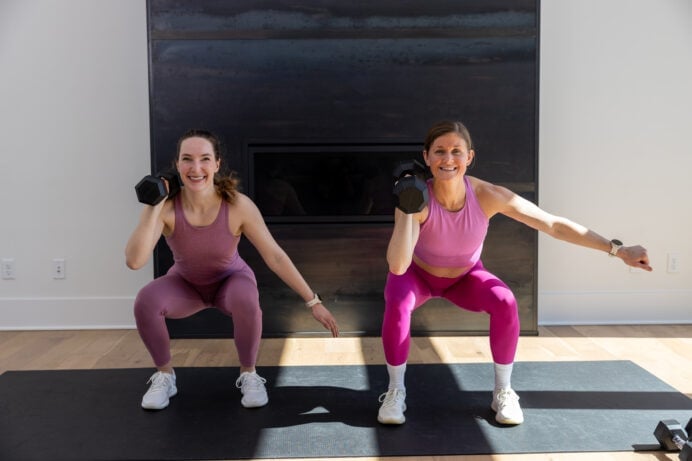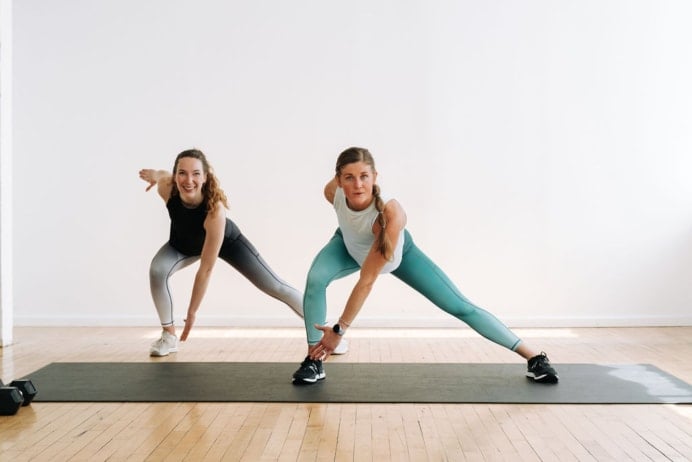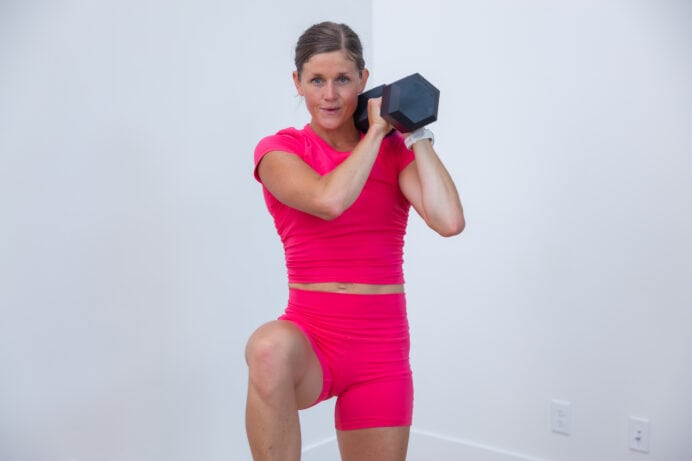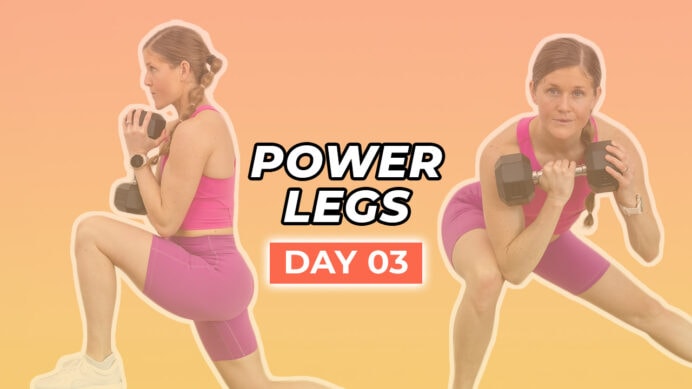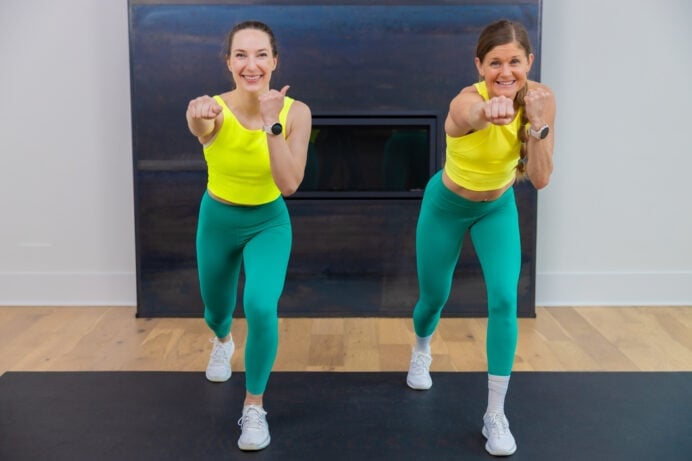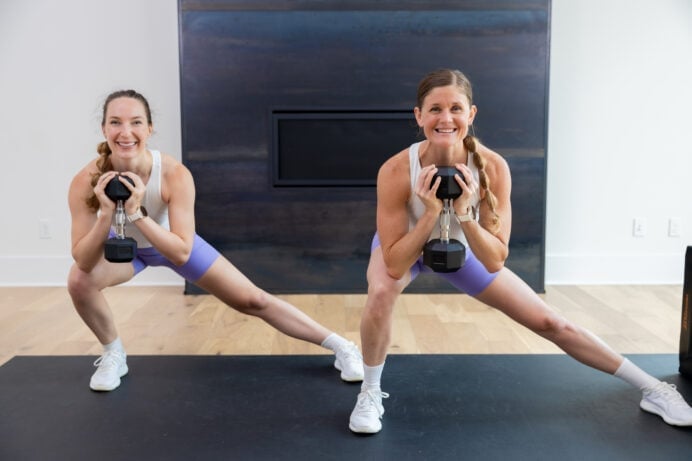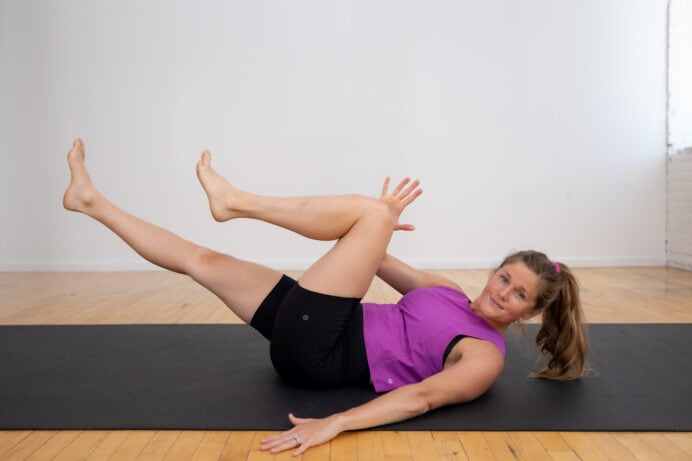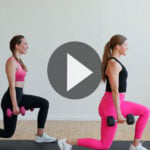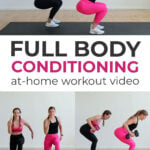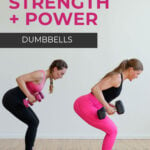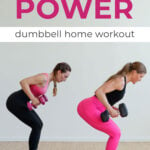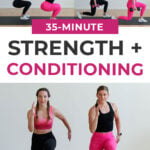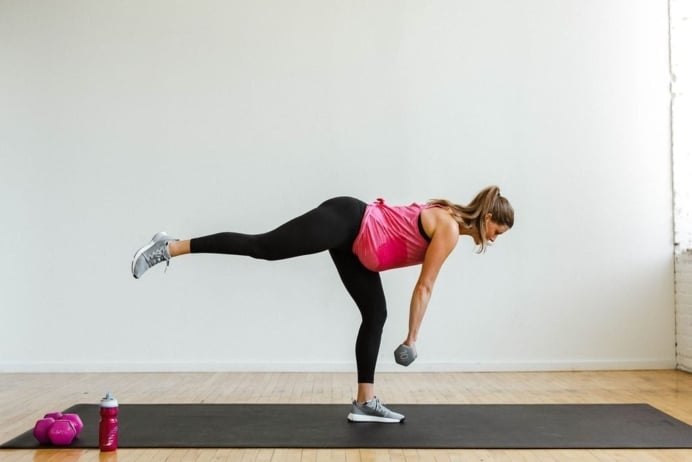
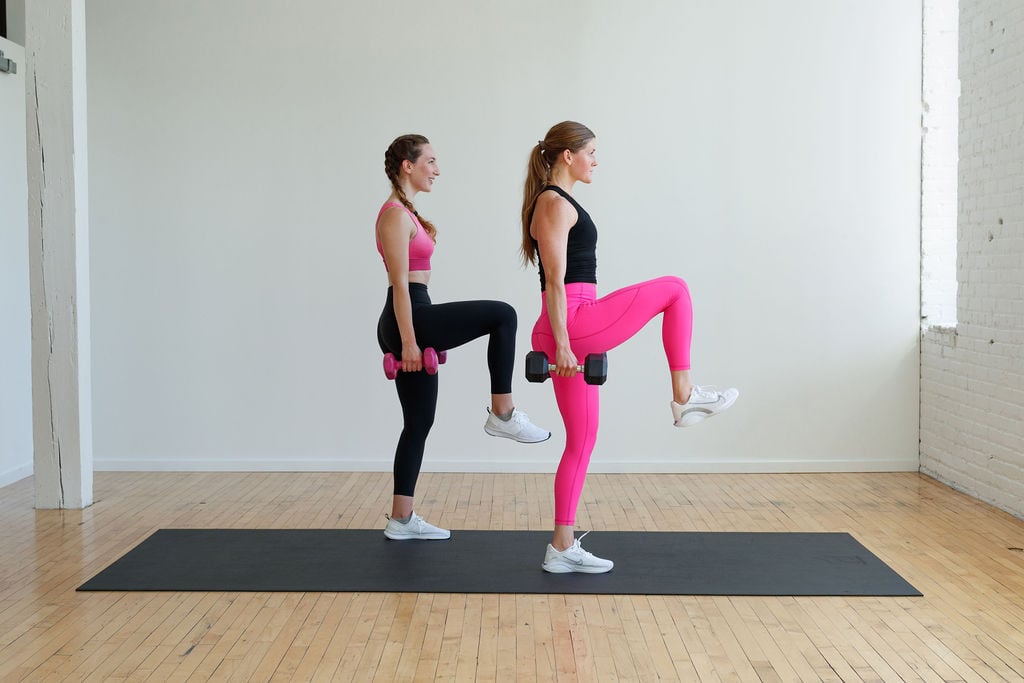
35-Minute Full Body Strength + Conditioning Workout
Build strength, burn fat and increase endurance with this strength and conditioning workout. This total body workout combines strength and plyometric exercises to challenge your muscular and cardio endurance, core stability and agility. Modifications are offered throughout to make this accessible for any fitness level.
Challenge both your cardio and muscular endurance with this full body strength and conditioning workout.
Strength and conditioning workouts are an important part of anyone’s training plan. The combination allows you to build muscle and improve heart health which is important for all fitness levels — not just athletes.
Today’s full body workout can be described as “complex training” or a workout that pairs a strength exercise with a power exercise (American Council on Exercise). This type of training can even out muscle imbalances, increase mobility and improve coordination.
In other words, you get all the benefits of heavy strength training and heart-pumping cardio in today’s workout.
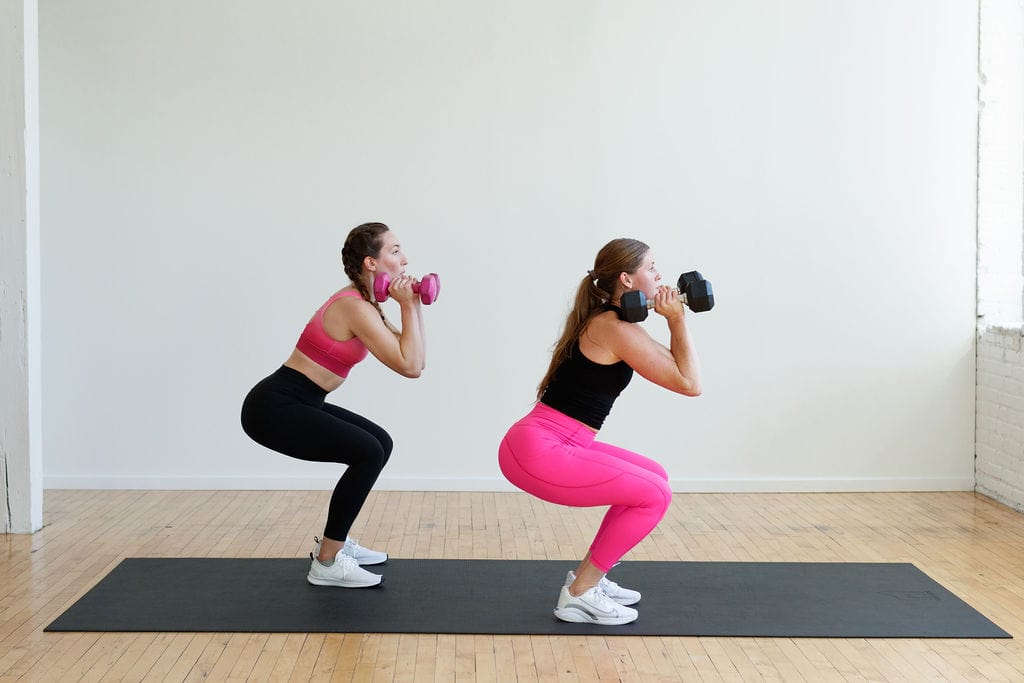
Strength and Conditioning Workout FAQs
Conditioning workouts combine dynamic, compound exercises that are designed to improve muscular strength and power. This type of training increases athletic performance and reduces risk of injury. Some of the most common training methods that personal trainers build into strength and conditioning workouts are weight training, endurance, mobility, core stability, speed, agility and plyometrics.
Strength and conditioning workouts have many benefits. Conditioning workouts efficiently build strength and increase endurance in a short period of time. They also increase “after burn” or the amount of energy your body continues to use after a workout, which can lead to fat burn and weight loss. This type of training can also even out muscle imbalances, increase mobility and improve coordination.
Conditioning or endurance workouts should challenge your muscular and cardio capacity. You need to give your body time to recover between strength and conditioning workout sessions. Most trainers recommend doing conditioning workouts no more than 2-3 times a week (American Council on Exercise). Check out my Free Home Workout Plans for guided workouts.
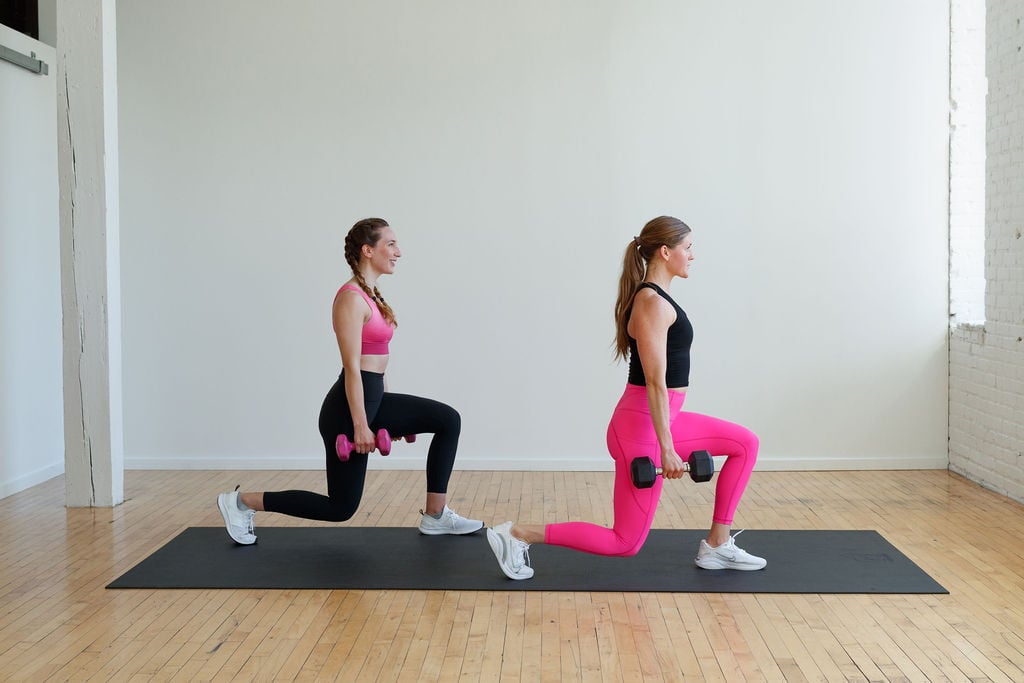
35-Minute Strength and Conditioning Workout
Challenge your total body strength and endurance with this conditioning workout.
This strength and HIIT (high intensity interval training) workout challenges you to complete a strength, power and conditioning exercise in each circuit.
I suggest doing this workout once a week as part of a well-rounded exercise program.
Workout Equipment:
A medium-to-heavy set of dumbbells.
I recommend 8-20 lbs depending on your fitness level. We’re using 12 and 15 lbs in this workout video.
Shop My Dumbbells
DISCOUNT CODE: NMLTQ5

Workout Instructions:
Follow along with the guided Strength and Conditioning Workout on YouTube, led by certified personal trainer, Lindsey Bomgren.
Your Workout Looks Like This:
- 4 Circuits (3 exercises per circuit)
- Timed Intervals (30 seconds of work per exercise. The first two exercises are consecutive, for a total work time of one minute. Then you get a 30 second rest, followed by a 30 second cardio conditioning/plyometric burnout.)
- Repeat Each Circuit x2-3 Sets
Workout Outline
CIRCUIT ONE:
- Strength: Dumbbell Squat (Floor Tap) and Curl and Press
- Power: Push Press
- Conditioning: 3 Lateral Bounds and 1 Squat Jump
CIRCUIT TWO:
- Strength: Reverse Lunge, Hammer Curl and Rotational Press
- Power: Weighted Single Leg Plyo Lunge
- Conditioning: Lateral Lunge and Lunge Jump Switch
CIRCUIT THREE:
- Strength: Hinge Swing and Narrow Squat
- Power: Bent Over Back Rows
- Conditioning: Weighted Squat Quick Split Taps
CIRCUIT FOUR:
- Strength: 2 Sumo Deadlifts and 1 Push Up
- Power: Push Ups
- Conditioning: Hand Release to “High 10” (Half Burpees)

Prefer to Watch On YouTube?
12 Strength and Conditioning Exercises
Dumbbell Squat (Floor Tap) and Curl and Press
Targets: Legs, glutes, quads, core, biceps and shoulders.
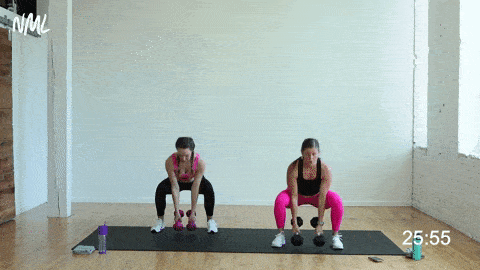
How To Do A Dumbbell Squat and Curl and Press
- Stand with your feet slightly wider than shoulder-width apart, knees bent, holding a dumbbell in each hand at your hips, palms facing in towards one another.
- Sit your hips back as you lower into a squat, bringing the heads of your dumbbells to lightly tap the floor.
- Then, drive through your heels to stand tall, curling the dumbbells up towards your shoulders as you stand. Keep your palms faced in for the entire curl (hammer curl).
- Once the dumbbells reach shoulder height, brace your core and press the dumbbells straight overhead for a shoulder press.
- Lower the dumbbells with control back to the starting position and repeat.
Push Press
Targets: Arms, shoulders, triceps, rear delts and upper back muscles (with some assistance from the lower body).
Note that pressing the dumbbells overhead increases core engagement and raises the heart rate.
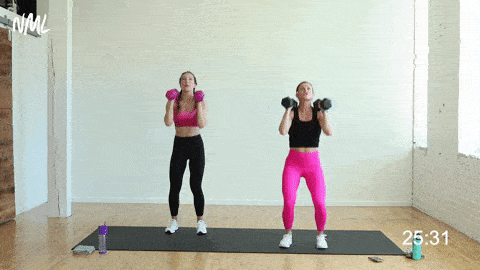
How To Do A Push Press
- Stand with feet shoulder-width apart, slight bend in your knees, holding one dumbbell in each hand at your shoulders, palms facing in towards each other (neutral grip).
- Drop into a shallow squat; about a 2-inch dip. Then press through your heels, and push the dumbbells overhead until arms are fully extended. Think of peeking your head through your arms as you lock out the dumbbells overhead.
- Lower the dumbbells down to the starting position at shoulder-level and repeat.
3 Lateral Bounds and 1 Squat Jump
Targets: Legs, quads, outer glutes (gluteus medius), inner thighs, calves and core.
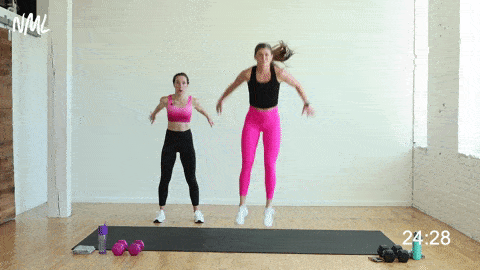
How To Do 3 Lateral Bounds and 1 Squat Jump
- Start standing on the right side of your mat with your feet shoulder-width apart.
- Lower down into an athletic stance, knees bent, ready to move.
- Then drive off your right leg to bound laterally to the left.
- Maintain the loaded squat stance as you perform 3 lateral bounds; always pushing off your outside leg (bound left, bound right, bound left).
- On the third count, perform a squat jump. Explode off both feet to leave the ground; using power from your legs.
- Land softly, then repeat.
Modification: Option to make this low impact by replacing the squat jump with an air squat.
Reverse Lunge and Hammer Curl with Rotational Press
Targets: Legs, glutes, quads, core, obliques, biceps and shoulders.
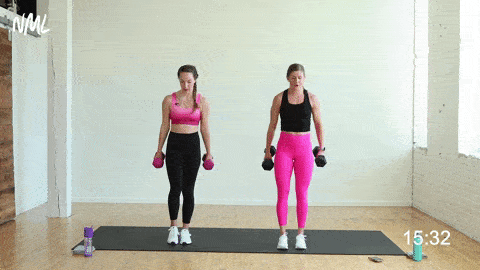
How To Do A Reverse Lunge and Hammer Curl with Rotational Press
- Start standing in a neutral position, feet hip-width apart, holding a dumbbell in each hand, palms facing in towards each other (hammer curl grip).
- Step your left foot back into a reverse lunge. Lowering your left knee towards the mat, aiming for 90 degree angles in both knees.
- As you step back into lunge, curl the dumbbells up half way, holding this half curl (90 degree bend at the elbows).
- Then rotate your torso as you “punch” the dumbbell in your left hand across your body.
- Rotate back to center and drive through your front, right heel to return to standing as you lower the dumbbells back to the starting position.
Modification: Option to omit the rotational press (twist).
Weighted Single Leg Plyo Lunge
Targets: Legs, glutes, quads, hamstrings, hips, calves, abs and core.
Weighted plyometrics increase muscular endurance and power.
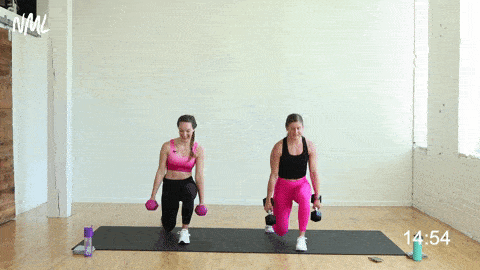
How To Do A Weighted Single Leg Plyo Lunge
- Start standing feet hip width apart, holding a dumbbell in each hand at your sides; palms facing in towards each other.
- Step your left foot back into a reverse lunge, lowering your back left knee towards the mat. Keep your dumbbells by your sides.
- Drive through your front right heel to explode up out of the lunge. As you return to standing drive your back, left knee up towards your chest. Option to add a small hop, exploding up as your right foot leaves the floor.
Modification: Option to omit the jump at the top.
Lateral Lunge and Lunge Jump Switch
Targets: Legs, glutes, quads, hips, hamstrings, outer glutes, inner thighs, calves and core.
Also great for balance and coordination.
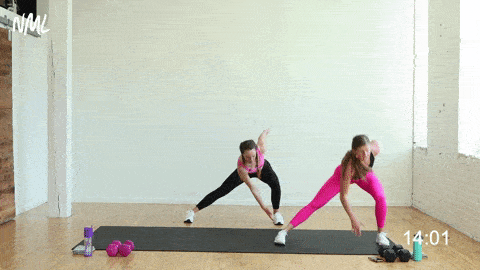
How To Do A Lateral Lunge and Lunge Jump Switch
- Start standing feet hip-distance apart, slight bend in your knees and core engaged.
- Step your right leg out to the side as you push your hips back, bending your right knee while leaving your left leg straight. Think of performing a single leg squat with your right leg while your left leg remains straight.
- Then, drive off your right foot to reverse the movement, pushing back to center.
- Immediately step your right foot back into a reverse lunge, aiming for 90 degree angles in each knee.
- Perform a “lunge jump” by exploding up from your reverse lunge position and switching legs in the air, so your right leg lands forward in a low lunge position and your left leg is now in the back.
- Return to standing and then perform a lateral lunge to the left.
- Repeat this pattern, alternating sides on the lateral lunge with each rep.
Modification: Option to make this low impact by omitting the lunge jump and instead performing step back lunges.
Hinge Swing and Narrow Squat
Targets: Legs, glutes, hamstrings, hips, quads and all the stabilizing muscles in the core.
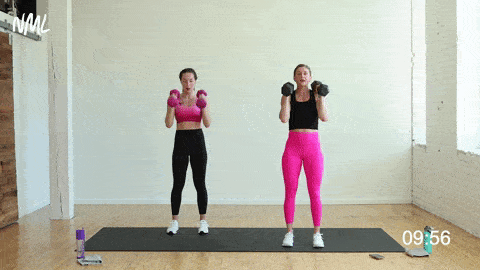
How To Do A Hinge Swing and Narrow Squat
- Start standing, feet shoulder-width apart with a soft bend in the knees. Holding one dumbbell in each hand at your sides (palms facing in towards each other).
- Hinge at the hips, pressing your butt back towards the wall behind you. As your hips go back, the dumbbells in your hands swing past your hips, arms extended long.
- Then press through your heels to stand tall, using the power in your hips, glutes and hamstrings to swing the dumbbells up to shoulder height.
- “Catch” the dumbbells at your shoulders, holding them in a front racked position.
- Then lower down into a narrow squat, aiming to get your thighs parallel to the ground.
- Push through your heels to stand tall.
Bent Over Back Rows
Targets: Posterior chain (backside of body); mainly the latissimus dorsi (lats or back muscles).
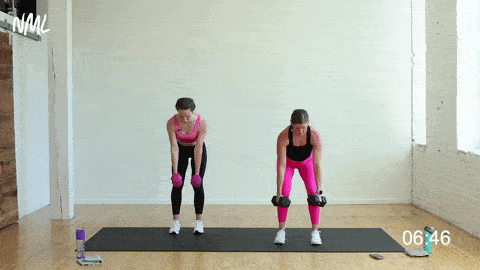
How To Do Bent Over Back Rows
- Stand with your feet shoulder-width apart, knees slightly bent.
- Grip a set of dumbbells, palms facing in towards each other.
- Hinge forward at the hips until your body is in a straight line, neck in line with your spine, flat back, and belly button pulled back towards your spine.
- Pull the weights back towards your hips, elbows pulling up towards your ribcage. Feel your shoulder blades squeeze together.
- Control the dumbbells back down to the starting position.
Weighted Squat Quick Split Taps
Targets: Legs, glutes, quads, calves, chest, shoulders and core.
Great footwork for speed and agility.
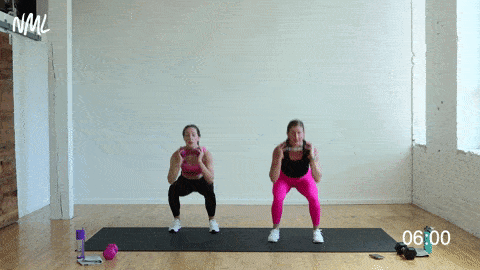
How To Do Weighted Squat Quick Split Taps
- Start in an athletic stance, feet slightly wider than hips, holding one dumbbell horizontally at your chest.
- Lower down into a squat, sitting your hips back and down and aiming to get your thighs parallel to the floor.
- Push through your heels to explosively return to standing.
- As you stand split your feet, jumping your right foot a few inches forward and your left foot a few inches back, landing softly in a staggered stance (as if your feet were staggered on railroad tracks)
- Hop your feet back to the starting position and repeat this movement.
Modification: Option to omit the hop and alternate tapping one foot forward each time you stand.
2 Sumo Deadlifts and 1 Push Up
Targets: Full body — legs, glutes, hamstrings, inner thighs, chest, shoulders, triceps, abs and core.
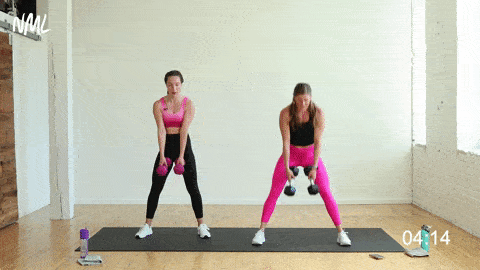
How To Do 2 Sumo Deadlifts and 1 Push Up
- Stand with feet wider than hips (sumo squat stance, heels slightly in, toes slightly out). Hold one dumbbell in each hand between your legs; palms facing in toward each other.
- Hinge your hips back as you lower the dumbbells in a straight line towards the ground; tapping the ground if you can. This is a sumo deadlift. Perform two reps of the sumo stance deadlift.
- Then, plant your dumbbells on the mat and step or hop back to a high plank position.
- Perform a push up. Lowering your chest towards the ground, elbows falling back towards your body.
- Push back to high plank, then step or jump your feet up to land outside your hands in a sumo stance and repeat.
Push Ups
Targets: Mainly the upper body — chest, shoulders, triceps, abs and core.
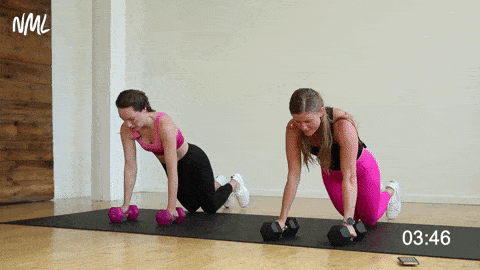
How To Do Push Ups
- Start in high plank position with your shoulders stacked over your wrists (or hands on weights).
- Lower your chest towards the ground, elbows fall back towards your body. Maintain a straight line with your body — head, chest and legs in one straight line.
- Exhale as you push back up into high plank position.
Modification: Option to perform modified push ups from a kneeling position. Or add an incline by placing your hands on a chair, couch, bench or countertop.
Hand Release “High 10” (Half Burpees)
Targets: Total body — legs, glutes, hamstrings, quads, low back, upper body, chest, shoulders, triceps and core.
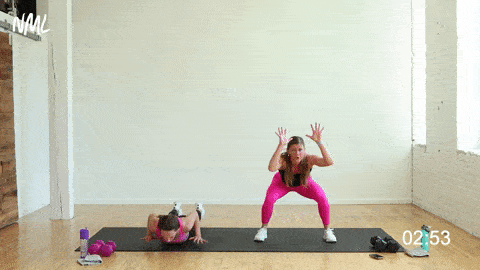
How To Do Hand Release “High 10” (Half Burpees)
- Start in high plank position with your shoulders stacked over your wrists, weight evenly distributed amongst all 10 fingers.
- With control, lower down to the mat, resting your stomach on the ground. Squeeze your shoulder blades together as you lift your palms off the ground and hold for a second, then return your hands to the mat.
- Push up to high plank position (in one straight line from knees or toes), then step or hop your feet outside your hands.
- Land softly in a low squat position, bringing your hands up in front of you as if you’re giving a high five (with both hands, so a “high ten”).
- Plant your hands on the mat and hop or step back to high plank position.
Modification: Option to step in and out of the high plank/burpee versus jumping.
More Workouts
Strength + HIITPin this Full Body Strength and Conditioning Workout:
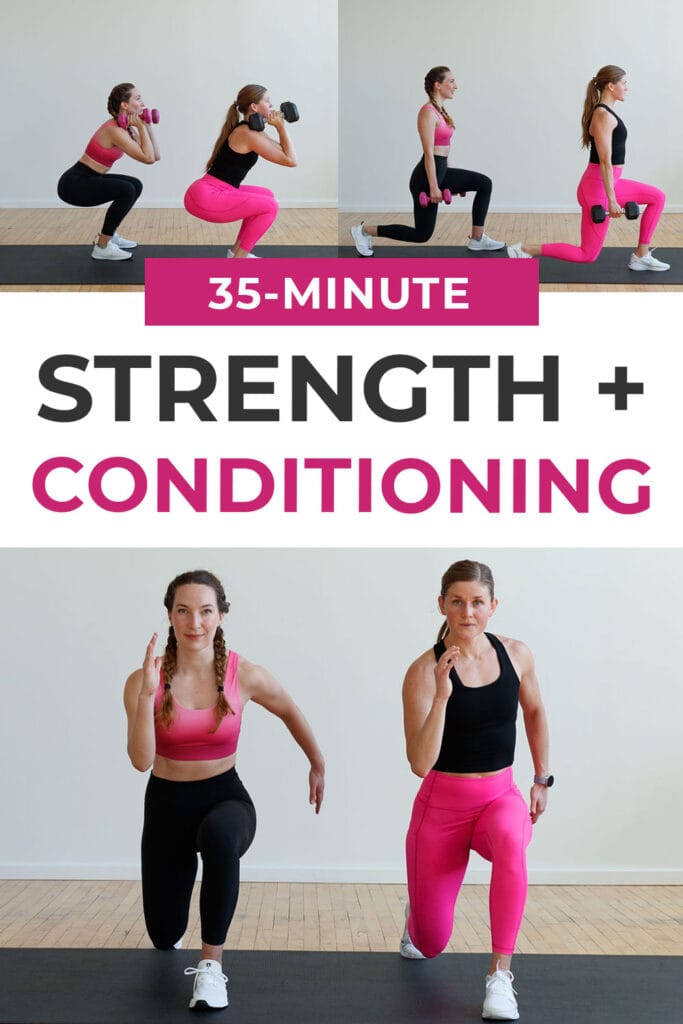
This post includes affiliate links. I do earn a commission for products purchased using these links (at no additional cost to you). Thank you for supporting Nourish Move Love, making the content you see on this blog possible.










